Can You Tell Your Buckle From Your Boy Bait? A Guide to Baked Fruit Desserts
Kinda like a cobbler, but entirely their own, the taxonomy of baked fruit desserts is more varied than you might think (and yes, "boy bait" is a real dessert).
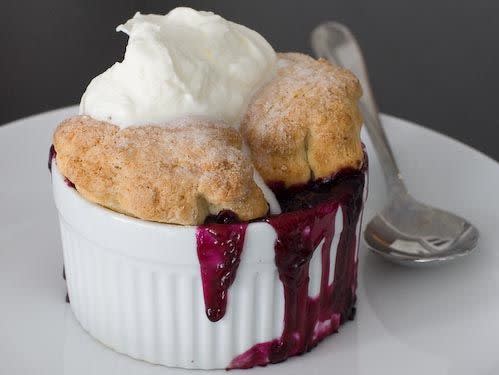
Serious Eats / Lauren Weisenthal
Pies are pretty easy to spot in the wild—you have your single crust and double crust varieties. There are ones with crumb, cream or meringue topping. There are ones that fit in your hand. For the most part pies look like pies. But what about their country cousin the cobbler? And those cobbler cousins: crumbles and crisps? Or Betties, pandowdys and sonkers? Can you tell a grunt from a slump? Here's your guide to spotting cobblers and other cobbler-like baked fruit desserts, so you can make prime use of the summer's harvest.
Cobbler
What is a cobbler? Well, as with much American cooking, it depends on whom you ask and where they're from. Kim Severson noted in the New York Times: "Unlike a classic pie, which everyone can pretty much agree on, the broader category of baked fruit desserts like cobblers and crisps is at once specific and general."
Though the provenance of the word cobbler has been lost to history, The Oxford English Dictionary traces the definition of cobbler back to John Russell Bartlett's Dict. Americanisms (1859) which defines the cobbler as thus: "A sort of pie, baked in a pot lined with dough of great thickness, upon which the fruit is placed; according to the fruit, it is an apple or a peach cobbler."
Turn through cookbooks from the late 19th century it's clear that what they thought of cobblers back then differs from what we think of as cobblers today. In his book The Lake of Red Cedars: Or Will it Live Thirty Years in Lake (1880) author Timothy Horton Ball, recalled a trip in 1848 describing "a large peach pie of a variety called by some 'peach cobbler,' the peaches in the pie being whole." In a story called Roxy by Edward Eggleston published in Belford's Monthly Magazine, Volume 3 (1878) described peach cobbler as "a monstrous dish of pastry inclosing [sic] whole peaches, pits and all."
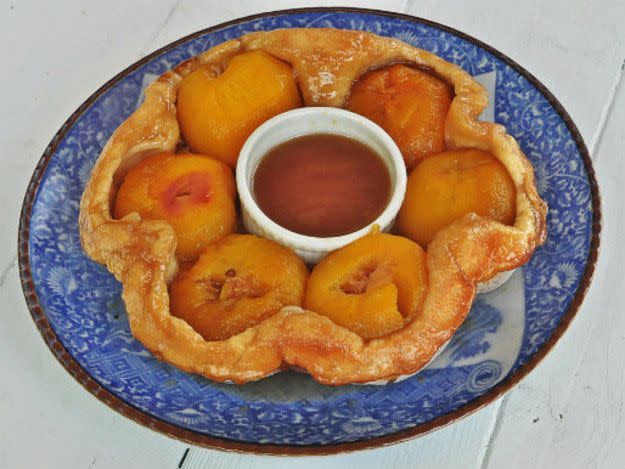
Serious Eats / Alexandra Penfold
An old fashioned peach puzzle.Yes, early printed recipes called for whole peaches and their pits to be placed in a deep dish lined with a thick pie dough then covered with dough on top. The pits were thought to impart additional flavor, but their inclusion also gives you a sense of how cobbler was a vector for disposing of plentiful fruit in season without making too much of a fuss. Towards the late 19th century peach cobbler recipes minus the bottom crust began appearing in print. The recipe published in Good House Keeping, Volume 9 in 1889 was made "without any under crust which is apt to soak with fruit juice, no matter how well it may be prepared." That same article advocated a "waste not" approach to their fruit advising readers that "...cobblers will give satisfaction, especially where the fruit is small, hard, or past its freshness."
In the All New, All Purpose Joy of Cooking 1997 edition, the authors had this to say about fruit desserts in the greater cobbler family: "These desserts seem descended from puddings on one side and pies on the other. They may be based on biscuit dough, pie dough, dumplings, bread crumbs, a crumbled flour-based topping, or cake; the fruit may be cooked under, over, or inside the dough or between dough layers."
Breaking it down to the basics, cobblers are deep dish dessert casseroles made of a sweetened fruit that forms a thick syrup when cooked. They can be topped with a sheet or "cobbles" biscuit or dumpling dough, as in this blueberry cobbler recipe. In some cases they may even be topped with pie dough. Some old fashioned variations of cobbler are inverted upon serving so the biscuits end up on the bottom, like this "Peach Puzzle." While some of the earliest cobbler recipes tend to feature apples or peaches, all of these desserts in the cobbler family work particularly well with pears, stone fruit and berries. There are many regional cobbler variations including sonkers, pandowdys, grunts, and slumps. While crisps, crumbles, crunches, and Betties lack the biscuit or dough component they are all similarly baked fruit dishes that wouldn't be out of place at a cobbler family reunion.
Crisp, Crumble, and Crunch
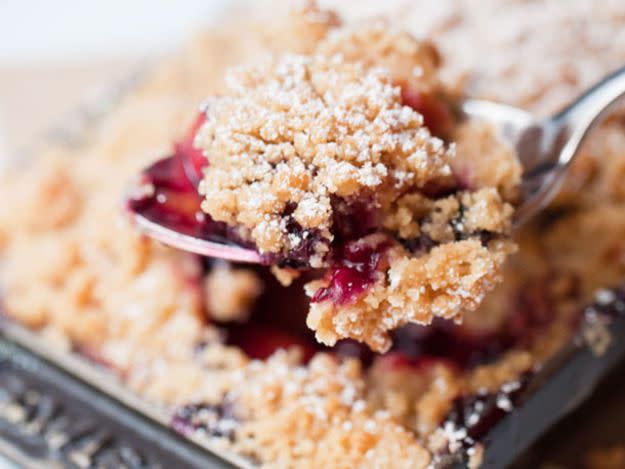
Crisp and crumble are regional names often used interchangeably to name a crumb-topped baked fruit dish. However, in the wilds of southern New England, crisps and crumbles are different in practice, so here's my colloquial explanation: Similar to a cobbler, a crisp is a deep dish fruit dessert that's topped with a streusel made of butter, sugar, flour, nuts, oats and/or crumbs or a combination of the three. The topping has a finer texture than a crumble.
Like a cobbler, a crumble consists of cooked fruit, however, instead of a biscuit topping, it has a crumb topping. The crumbs are typically made of butter or shortening, flour and sugar, oats and a pinch of salt and can include nuts. While crisp and crumble toppings are both rather crumbly, unlike a crisp, crumble topping always uses oats. The texture of crumble crumbs is clumpier than the crumb-topping on a crisp.
If a crisp and crumble are defined by their crumbs, what's a crunch? Even more crumbs! The Joy of Cooking calls a crunch "fruit sandwiched between two layers of sweetened, buttered crumbs; it is served cut into squares like bar cookies, but is a bit more fragile."
Betty
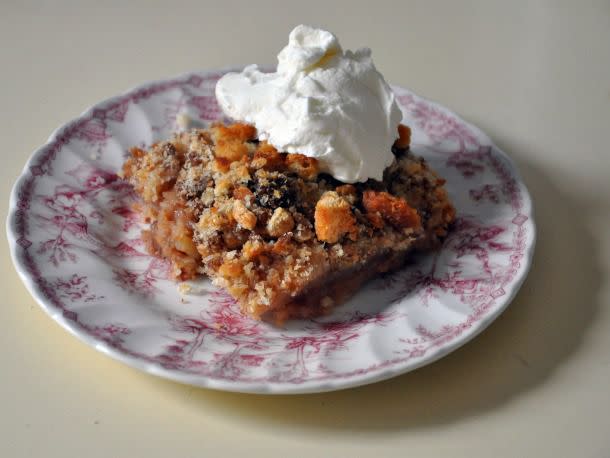
Popular in colonial times, this baked dessert is typically made up of layers of sliced apples and buttered bread crumbs. The saying may go "as American as apple pie" but I would venture that the simplicity and thrift embodied in an Apple Brown Betty is much more in keeping with the pioneer spirit. It takes just a few pantry basics—if you have stale bread, apples, butter and cinnamon, you're already halfway there. There's no crust to chill and roll, no crumble to mix, no biscuits to prep.
Bird's Nest Pudding
Despite its name, some iterations of Bird's Nest Puddings actually share much in common with cobblers. To prepare this old timey dish, you peel and core several tart apples, add them to a casserole dish (or what they used to call a "pudding dish") then cover them with a batter of milk, eggs, and flour then bake it until it's nicely browned. In some variations of this recipe the apples were filled with sugar and entirely covered with more of a biscuit-like topping while other variations went more of a true custard route essentially baking apples in a sea of custard. Traditionally it was served with a sweetened cold sauce made of butter, sugar and nutmeg. Other fruit studded baked custards like the French claufouti could be considered a close relative of the Bird's Nest Pudding.
Buckle
A buckle is a funny name for an old fashioned fruit studded coffee cake. Like many other desserts in the extended cobbler family buckles take their name from their appearance—grunts grunt as they cook, slumps slump when served, buckles—you guessed it—buckle. The Boston Examiner defines it as a "single-layer cake with a streusel topping" saying "as the cake bakes, the dense batter sinks to the bottom of the pan, which makes the streusel buckle on top." Buckles tend to be made with berries like the strawberry one above. Kuchen might be considered the buckle's German cousin.
Shortcake
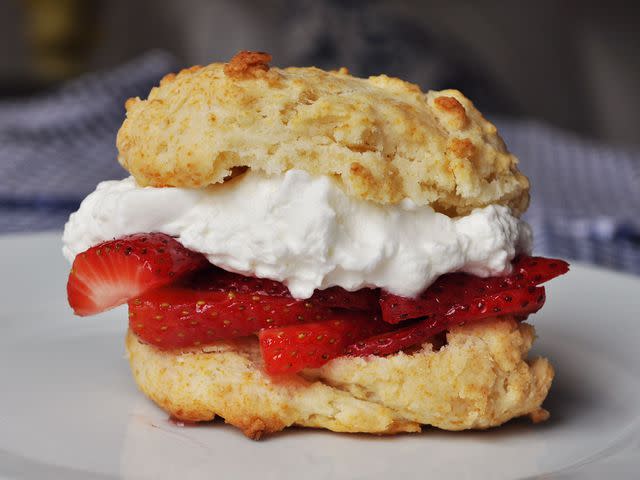
Shortcakes are traditionally made up of lightly sweetened biscuits topped with lightly sweetened fresh fruit and cream. If you think about it, shortcakes are sort of a tidied up individual portion of a cobbler. Shortcakes and cobbler exist on opposite ends of the fruit freshness spectrum. Shortcakes are for showcasing fruit, like strawberries at their peak while cobbler allows you to use fruit that's not quite in its prime.
Long-cake
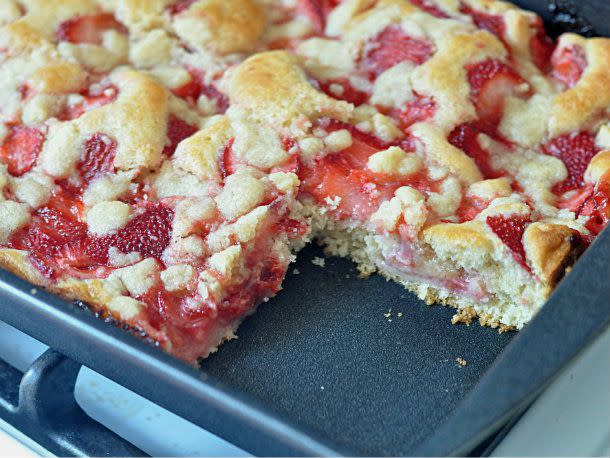
Long-cakes are a quick and easy one-pan coffee cake that would easily feel at home amongst a cobbler crew.The buttery and tender cake batter is spread with macerated strawberries and finished with a clumpy butter/sugar/flour topping (not unlike a buckle).
Boy Bait
Boy Bait is a fruited coffee cake that's similar to a buckle and hails from the archives of the Pillsbury Bake-Off. According to Yankee Magazine, a "15-year-old Chicago teen named Renny Powell submitted a blueberry coffee cake recipe to the Pillsbury...[and] took second place in the youth division for her creation, named in honor of its powers with the opposite sex." Unlike a buckle, boy bait doesn't have streusel topping.
Grunt
Grunts are biscuit or dumpling-topped stewed fruit desserts that are cooked on the stovetop in a covered Dutch oven or cast iron skillet. The dessert is native to New England. They are very close to cobblers in construction but the topping is steamed cooked on the stovetop rather than baked. They take their funny name from the bubbling sound they make as they cook.
Slump
Slumps are essentially a regional variation of a cobbler—a baked biscuit or dumpling topped stewed fruit dish. Thrifty (and decidedly unfancy) New Englanders named them for their "slumpy" appearance.
Pandowdy
A pandowdy is another deep dish stewed fruit dessert similar to a cobbler but made with a different technique. Here the biscuit dough (or pie dough) is rolled out and spread over the top of the fruit and set to bake. Partially through cooking the pandowdy is removed from the oven and the topping is broken up and pushes into the filling with a spoon which allows the filling to bubble up. The origins of the unusual name aren't clear, but is suspected that it comes from the dessert's rather humble appearance. Apple pandowdies are the most common, though you can make it with other fruit.
Sonker
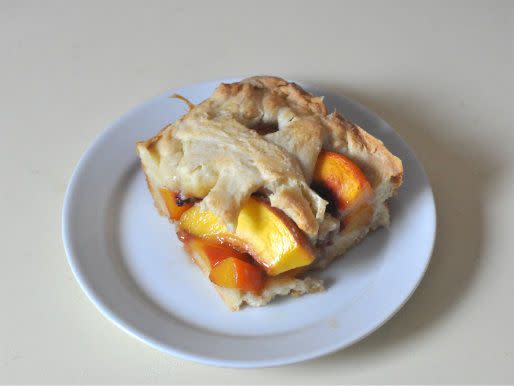
Sonkers are an Appalachian cobbler variation native to Surry County, North Carolina. They are also the hardest variety to pin down. Though sonkers are native to a small area, the recipes that have been passed from generation to generation vary widely to create a diverse cobbler subset. In Pamela Goyan Kittler and Kathryn P. Sucher's book Food and Culture, they describe sonkers as "a deep-dish fruit or sweet potato pie made with breadcrumbs or biscuit dough or pie crust—there is no agreement on how to prepare it." Varieties include apple, blackberry, blueberry, cherry, strawberry, sweet potato, and, as in the photo above, peach. Kim Severson's sonker quest for The New York Times yielded this definition: "A soupy, deep-dish baked dessert of sweet potatoes or fruit topped with a crust or a batter . . . You might have a hard time distinguishing it from a cobbler unless you grew up there." While there may not be one surefire recipe for sonkers, they are deep dish fare made to feed a hungry crowd.

